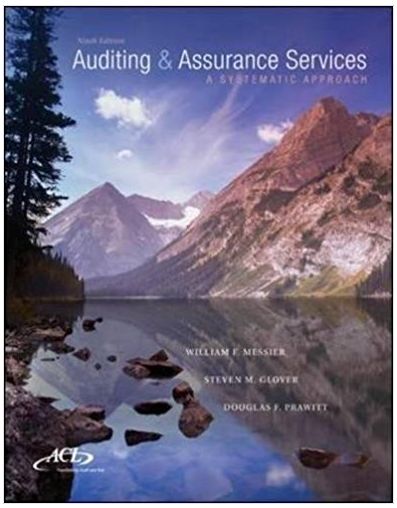Multiple Choice 1. Which of the following concepts are pervasive in the application of generally accepted auditing
Question:
Multiple Choice
1. Which of the following concepts are pervasive in the application of generally accepted auditing standards, particularly the standards of field work and reporting?
a. Internal control.
b. Expected misstatement.
c. Control risk.
d. Materiality and audit risk.
2. The existence of audit risk is recognized by the statement in the auditor’s standard report that the auditor
a. Obtains reasonable assurance about whether the financial statements are free of material misstatement.
b. Assesses the accounting principles used and evaluates the overall financial statement presentation.
c. Realizes that some matters, either individually or in the aggregate, are important, while other matters are not important.
d. Is responsible for expressing an opinion on the financial statements, which are the responsibility of management.
3. Risk of material misstatement refers to a combination of which two “ client” components of the audit risk model?
a. Audit risk and inherent risk.
b. Audit risk and control risk.
c. Inherent risk and control risk.
d. Control risk and detection risk.
4. As lower acceptable levels of both audit risk and materiality are established, the auditor should plan more work on individual accounts to
a. Find smaller errors.
b. Find larger errors.
c. Increase the tolerable misstatements in the accounts.
d. Decrease the risk of overreliance.
5. When is a duty to disclose fraud to parties other than the client’s senior management and its audit committee most likely to exist?
a. When the amount is material.
b. When the fraud results from misappropriation of assets rather than fraudulent financial reporting.
c. In response to inquiries from a successor auditor.
d. When a line manager rather than a lower- level employee commits the fraudulent act.
6. Which of the following characteristics most likely would heighten an auditor’s concern about the risk of intentional manipulation of financial statements?
a. Turnover of senior accounting personnel is low.
b. Insiders recently purchased additional shares of the entity’s stock.
c. Management places substantial emphasis on meeting earnings projections.
d. The rate of change in the entity’s industry is slow.
7. Which of the following is a misappropriation of assets?
a. Classifying inventory held for resale as supplies.
b. Investing cash and earning a 3 percent rate of return as opposed to paying off a loan with an interest rate of 7 percent.
c. An employee of a consumer electronics store steals 12 CD players.
d. Management estimates bad debt expense as 2 percent of sales when it actually expects bad debts equal to 10 percent of sales.
8. Auditing standards require auditors to make certain inquiries of management regarding fraud. Which of the following inquiries is required?
a. Whether management has ever intentionally violated the securities laws.
b. Whether management has any knowledge of fraud that has been perpetrated on or within the entity.
c. Management’s attitudes toward regulatory authorities.
d. Management’s attitude about hiring ethical employees.
9. Which of the following is an example of fraudulent financial reporting?
a. Company management falsifies the inventory count, thereby overstating ending inventory and understating cost of sales.
b. An employee diverts customer payments to his personal use, concealing his actions by debiting an expense account, thus overstating expenses.
c. An employee steals inventory, and the shrinkage is recorded as a cost of goods sold. d. An employee borrows small tools from the company and neglects to return them; the cost is reported as a miscellaneous operating expense.
10. Which of the following is correct concerning required auditor communications about fraud?
a. Fraud that involves senior management should be reported directly by the auditor to the audit committee regardless of the amount involved.
b. Fraud with a material effect on the financial statements should be reported directly by the auditor to the Securities and Exchange Commission.
c. Any requirement to disclose fraud outside the entity is the responsibility of management and not that of the auditor.
d. The professional standards provide no requirements related to the communication of fraud, but the auditor should use professional judgment in determining communication responsibilities.
Ending InventoryThe ending inventory is the amount of inventory that a business is required to present on its balance sheet. It can be calculated using the ending inventory formula Ending Inventory Formula =... Financial Statements
Financial statements are the standardized formats to present the financial information related to a business or an organization for its users. Financial statements contain the historical information as well as current period’s financial...
Step by Step Answer:

Auditing and Assurance Services A Systematic Approach
ISBN: 978-1259162343
9th edition
Authors: William Messier, Steven Glover, Douglas Prawitt





